Managerial Accounting Report: Costing Systems in Contemporary Business
VerifiedAdded on 2023/01/16
|13
|4057
|89
Report
AI Summary
This report provides an in-depth analysis of managerial accounting, focusing on the features and applications of standard costing as a planning and control system. It explores standard costing within the context of a real-life case company, Beximco Pharmaceuticals Ltd, highlighting its relevance in the pharmaceutical industry. The report further delves into a comparative analysis of target costing and standard costing, discussing the former's relevance in today's competitive and uncertain business environment. It outlines the target costing process and its significance in cost management. The report concludes by recommending appropriate systems of management accounting for contemporary organizations, emphasizing the importance of effective controls and planning processes. The report also discusses the limitations of standard costing and its relevance in today's manufacturing world.
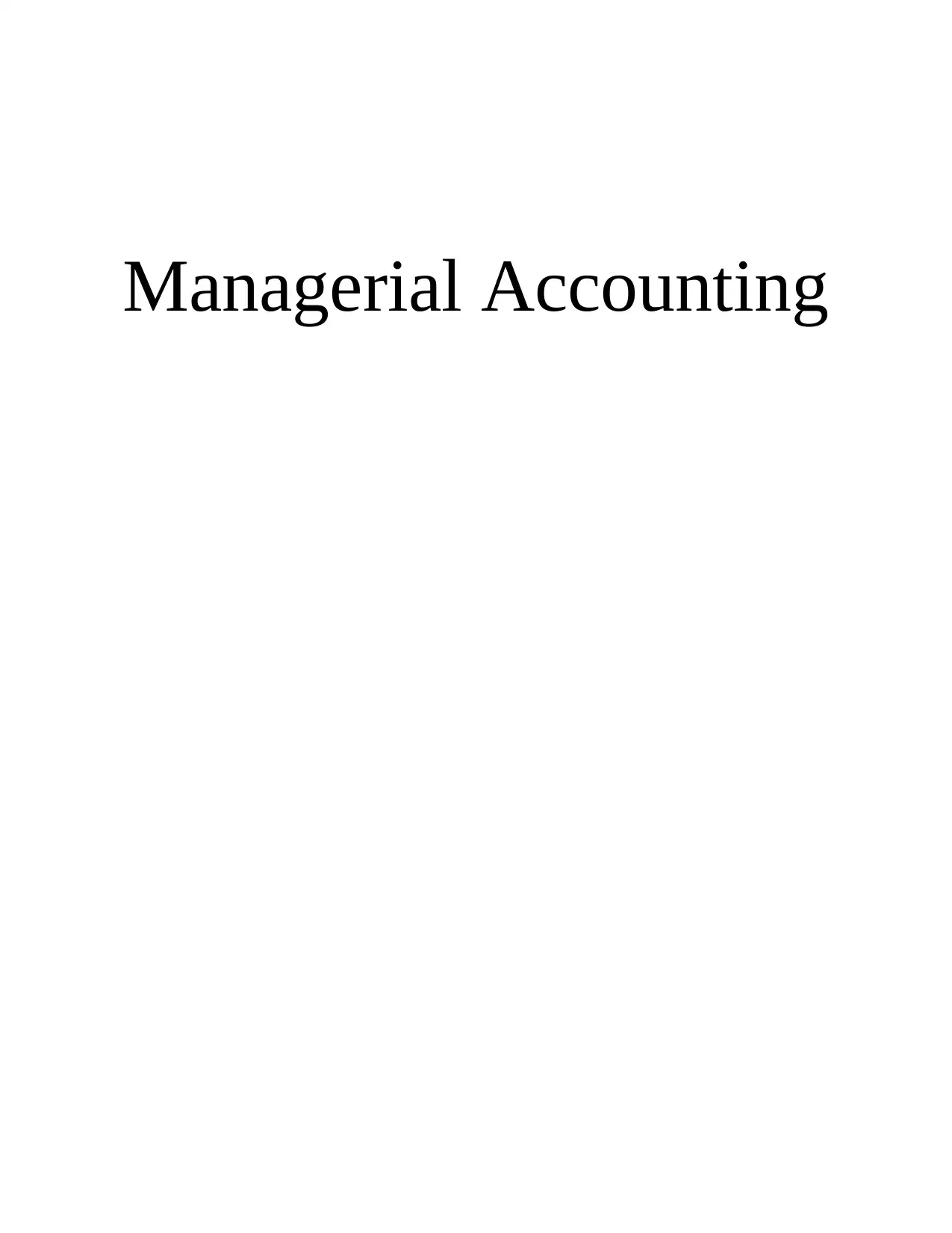
Managerial Accounting
Paraphrase This Document
Need a fresh take? Get an instant paraphrase of this document with our AI Paraphraser
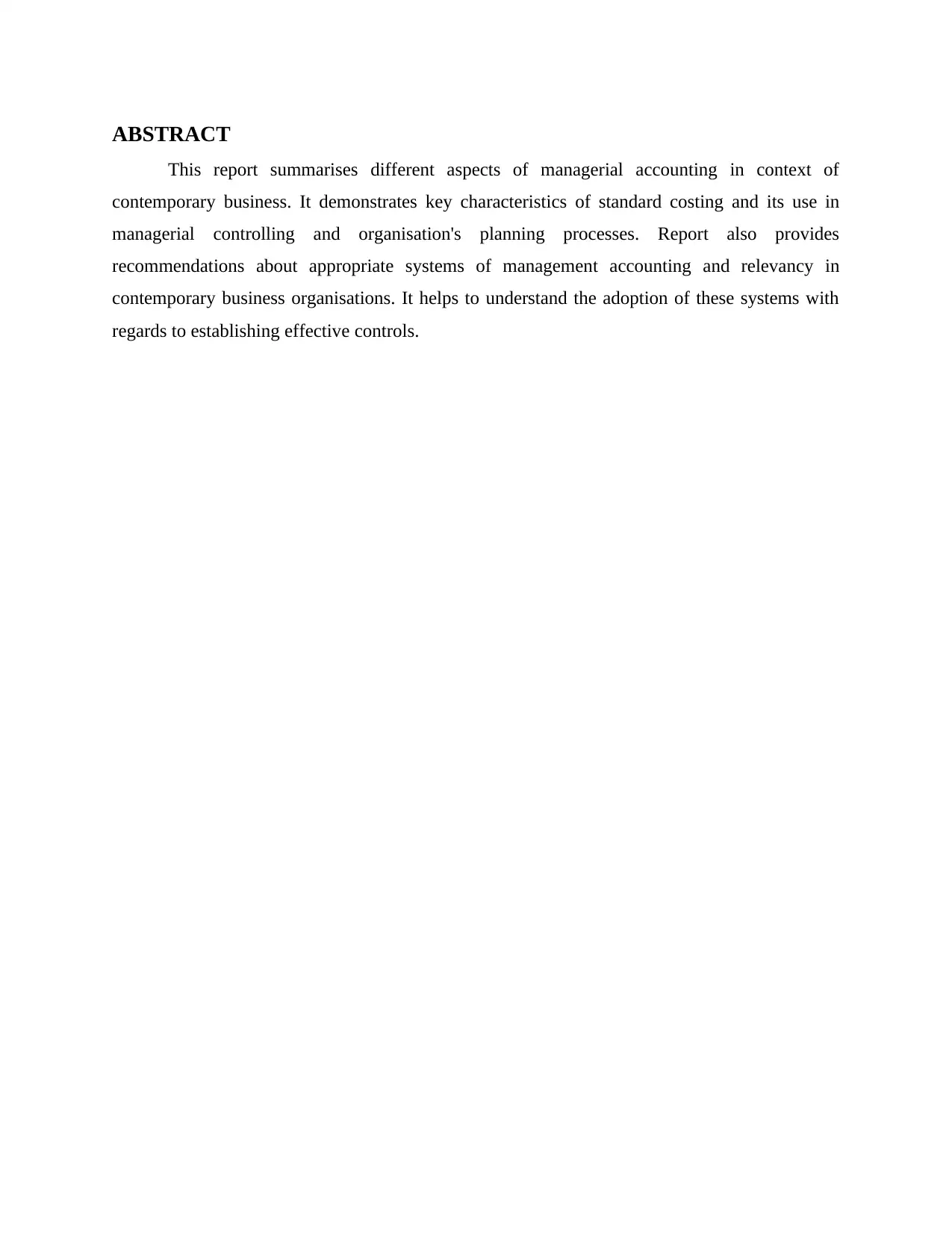
ABSTRACT
This report summarises different aspects of managerial accounting in context of
contemporary business. It demonstrates key characteristics of standard costing and its use in
managerial controlling and organisation's planning processes. Report also provides
recommendations about appropriate systems of management accounting and relevancy in
contemporary business organisations. It helps to understand the adoption of these systems with
regards to establishing effective controls.
This report summarises different aspects of managerial accounting in context of
contemporary business. It demonstrates key characteristics of standard costing and its use in
managerial controlling and organisation's planning processes. Report also provides
recommendations about appropriate systems of management accounting and relevancy in
contemporary business organisations. It helps to understand the adoption of these systems with
regards to establishing effective controls.
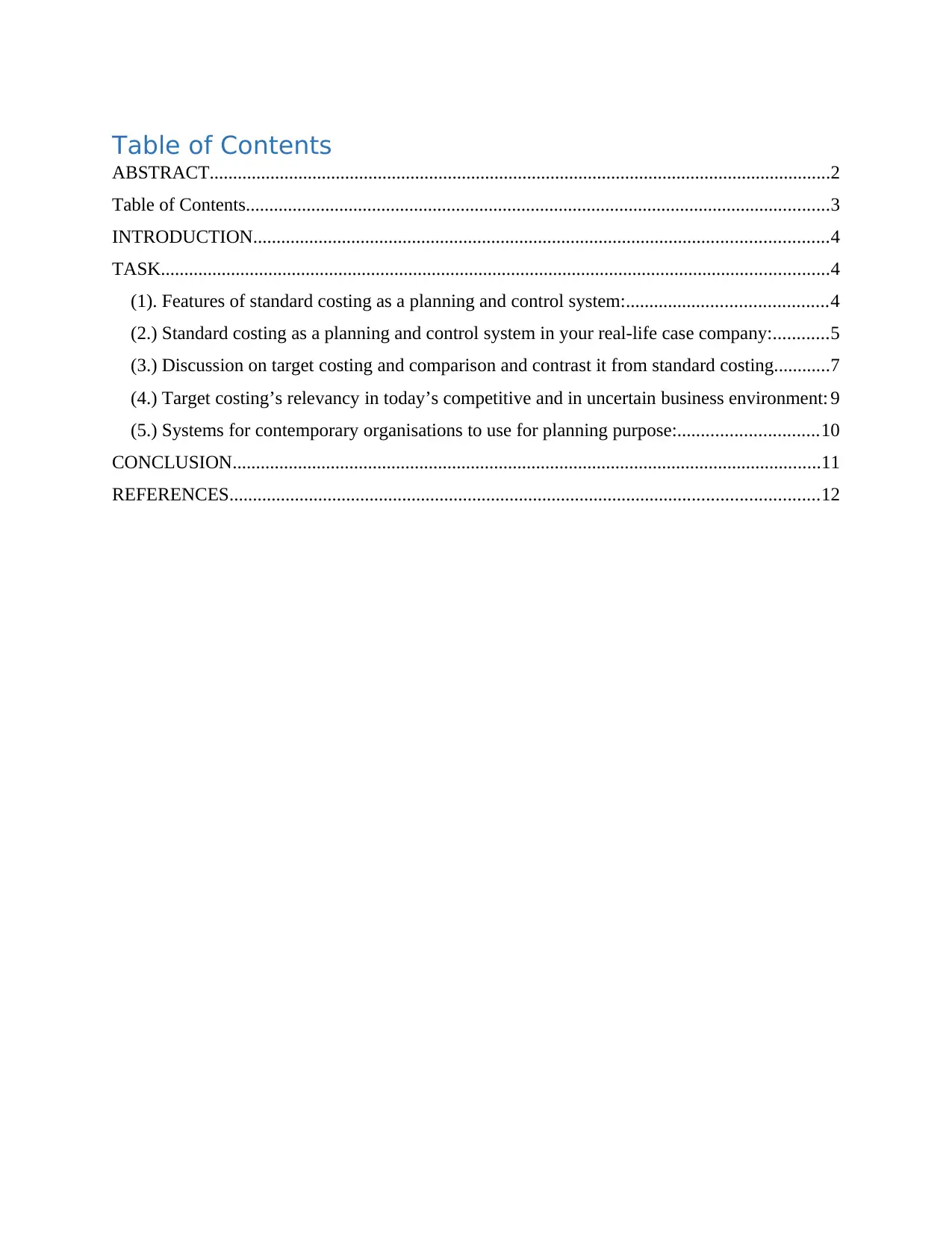
Table of Contents
ABSTRACT.....................................................................................................................................2
Table of Contents.............................................................................................................................3
INTRODUCTION...........................................................................................................................4
TASK...............................................................................................................................................4
(1). Features of standard costing as a planning and control system:...........................................4
(2.) Standard costing as a planning and control system in your real-life case company:............5
(3.) Discussion on target costing and comparison and contrast it from standard costing............7
(4.) Target costing’s relevancy in today’s competitive and in uncertain business environment: 9
(5.) Systems for contemporary organisations to use for planning purpose:..............................10
CONCLUSION..............................................................................................................................11
REFERENCES..............................................................................................................................12
ABSTRACT.....................................................................................................................................2
Table of Contents.............................................................................................................................3
INTRODUCTION...........................................................................................................................4
TASK...............................................................................................................................................4
(1). Features of standard costing as a planning and control system:...........................................4
(2.) Standard costing as a planning and control system in your real-life case company:............5
(3.) Discussion on target costing and comparison and contrast it from standard costing............7
(4.) Target costing’s relevancy in today’s competitive and in uncertain business environment: 9
(5.) Systems for contemporary organisations to use for planning purpose:..............................10
CONCLUSION..............................................................................................................................11
REFERENCES..............................................................................................................................12
⊘ This is a preview!⊘
Do you want full access?
Subscribe today to unlock all pages.

Trusted by 1+ million students worldwide
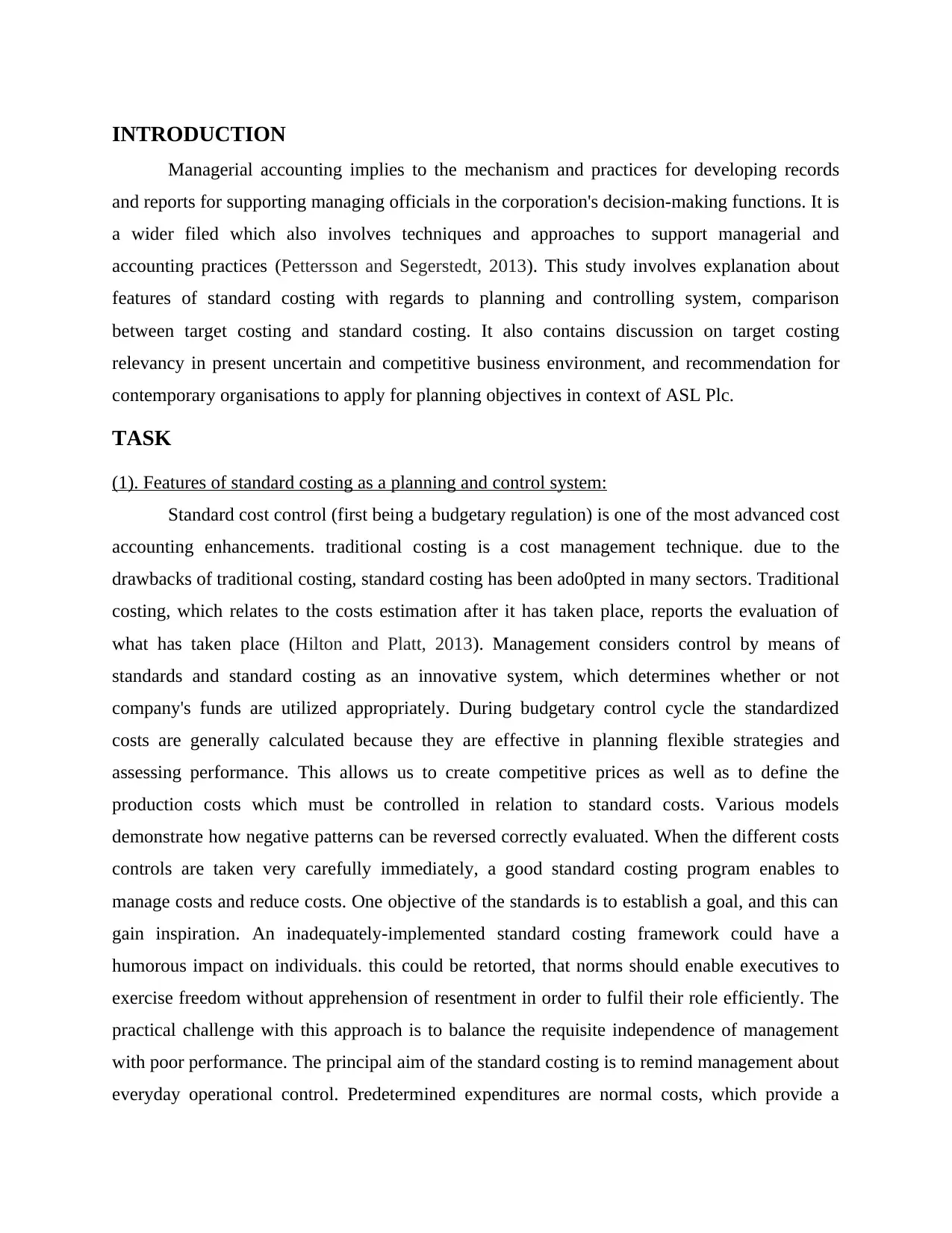
INTRODUCTION
Managerial accounting implies to the mechanism and practices for developing records
and reports for supporting managing officials in the corporation's decision-making functions. It is
a wider filed which also involves techniques and approaches to support managerial and
accounting practices (Pettersson and Segerstedt, 2013). This study involves explanation about
features of standard costing with regards to planning and controlling system, comparison
between target costing and standard costing. It also contains discussion on target costing
relevancy in present uncertain and competitive business environment, and recommendation for
contemporary organisations to apply for planning objectives in context of ASL Plc.
TASK
(1). Features of standard costing as a planning and control system:
Standard cost control (first being a budgetary regulation) is one of the most advanced cost
accounting enhancements. traditional costing is a cost management technique. due to the
drawbacks of traditional costing, standard costing has been ado0pted in many sectors. Traditional
costing, which relates to the costs estimation after it has taken place, reports the evaluation of
what has taken place (Hilton and Platt, 2013). Management considers control by means of
standards and standard costing as an innovative system, which determines whether or not
company's funds are utilized appropriately. During budgetary control cycle the standardized
costs are generally calculated because they are effective in planning flexible strategies and
assessing performance. This allows us to create competitive prices as well as to define the
production costs which must be controlled in relation to standard costs. Various models
demonstrate how negative patterns can be reversed correctly evaluated. When the different costs
controls are taken very carefully immediately, a good standard costing program enables to
manage costs and reduce costs. One objective of the standards is to establish a goal, and this can
gain inspiration. An inadequately-implemented standard costing framework could have a
humorous impact on individuals. this could be retorted, that norms should enable executives to
exercise freedom without apprehension of resentment in order to fulfil their role efficiently. The
practical challenge with this approach is to balance the requisite independence of management
with poor performance. The principal aim of the standard costing is to remind management about
everyday operational control. Predetermined expenditures are normal costs, which provide a
Managerial accounting implies to the mechanism and practices for developing records
and reports for supporting managing officials in the corporation's decision-making functions. It is
a wider filed which also involves techniques and approaches to support managerial and
accounting practices (Pettersson and Segerstedt, 2013). This study involves explanation about
features of standard costing with regards to planning and controlling system, comparison
between target costing and standard costing. It also contains discussion on target costing
relevancy in present uncertain and competitive business environment, and recommendation for
contemporary organisations to apply for planning objectives in context of ASL Plc.
TASK
(1). Features of standard costing as a planning and control system:
Standard cost control (first being a budgetary regulation) is one of the most advanced cost
accounting enhancements. traditional costing is a cost management technique. due to the
drawbacks of traditional costing, standard costing has been ado0pted in many sectors. Traditional
costing, which relates to the costs estimation after it has taken place, reports the evaluation of
what has taken place (Hilton and Platt, 2013). Management considers control by means of
standards and standard costing as an innovative system, which determines whether or not
company's funds are utilized appropriately. During budgetary control cycle the standardized
costs are generally calculated because they are effective in planning flexible strategies and
assessing performance. This allows us to create competitive prices as well as to define the
production costs which must be controlled in relation to standard costs. Various models
demonstrate how negative patterns can be reversed correctly evaluated. When the different costs
controls are taken very carefully immediately, a good standard costing program enables to
manage costs and reduce costs. One objective of the standards is to establish a goal, and this can
gain inspiration. An inadequately-implemented standard costing framework could have a
humorous impact on individuals. this could be retorted, that norms should enable executives to
exercise freedom without apprehension of resentment in order to fulfil their role efficiently. The
practical challenge with this approach is to balance the requisite independence of management
with poor performance. The principal aim of the standard costing is to remind management about
everyday operational control. Predetermined expenditures are normal costs, which provide a
Paraphrase This Document
Need a fresh take? Get an instant paraphrase of this document with our AI Paraphraser
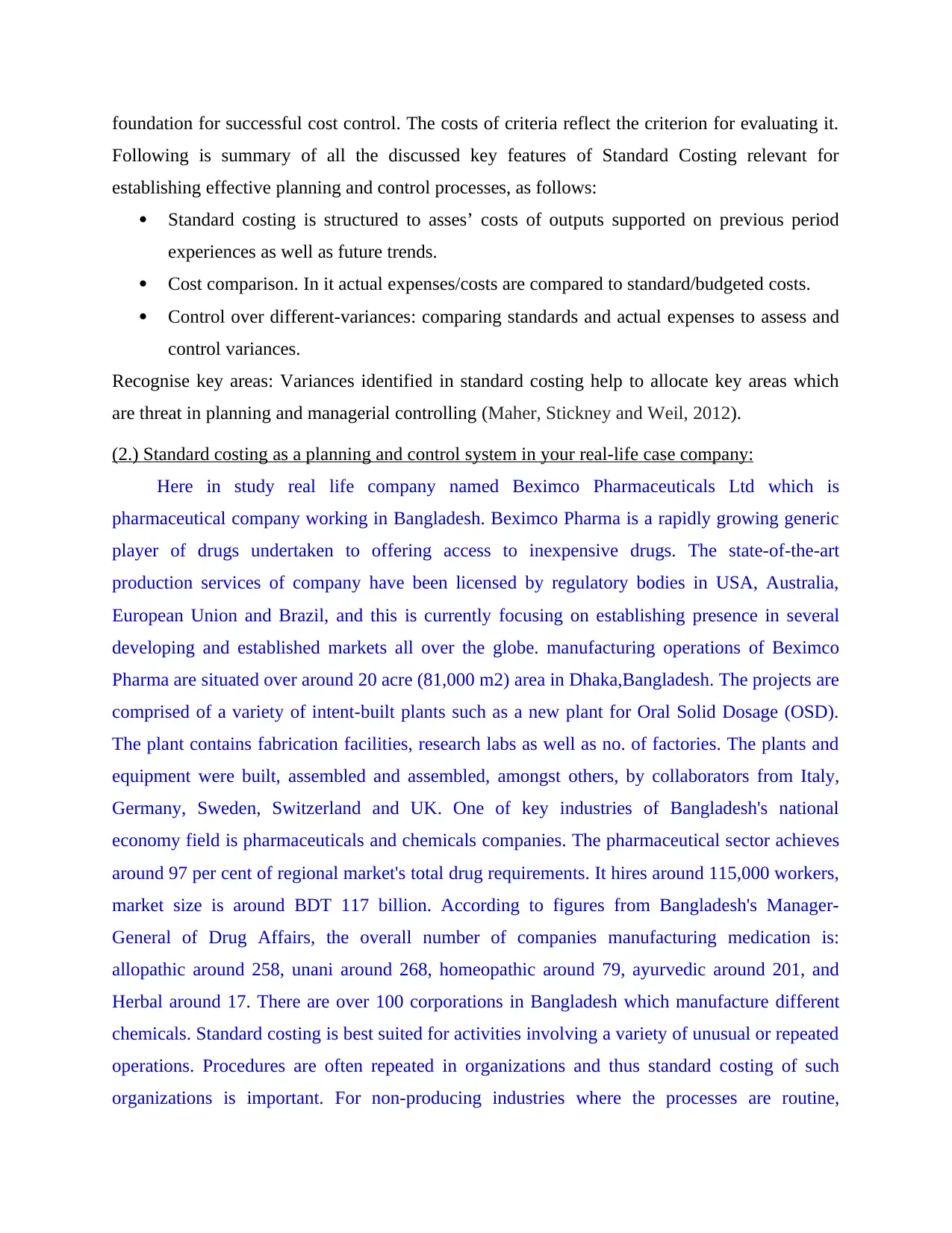
foundation for successful cost control. The costs of criteria reflect the criterion for evaluating it.
Following is summary of all the discussed key features of Standard Costing relevant for
establishing effective planning and control processes, as follows:
Standard costing is structured to asses’ costs of outputs supported on previous period
experiences as well as future trends.
Cost comparison. In it actual expenses/costs are compared to standard/budgeted costs.
Control over different-variances: comparing standards and actual expenses to assess and
control variances.
Recognise key areas: Variances identified in standard costing help to allocate key areas which
are threat in planning and managerial controlling (Maher, Stickney and Weil, 2012).
(2.) Standard costing as a planning and control system in your real-life case company:
Here in study real life company named Beximco Pharmaceuticals Ltd which is
pharmaceutical company working in Bangladesh. Beximco Pharma is a rapidly growing generic
player of drugs undertaken to offering access to inexpensive drugs. The state-of-the-art
production services of company have been licensed by regulatory bodies in USA, Australia,
European Union and Brazil, and this is currently focusing on establishing presence in several
developing and established markets all over the globe. manufacturing operations of Beximco
Pharma are situated over around 20 acre (81,000 m2) area in Dhaka,Bangladesh. The projects are
comprised of a variety of intent-built plants such as a new plant for Oral Solid Dosage (OSD).
The plant contains fabrication facilities, research labs as well as no. of factories. The plants and
equipment were built, assembled and assembled, amongst others, by collaborators from Italy,
Germany, Sweden, Switzerland and UK. One of key industries of Bangladesh's national
economy field is pharmaceuticals and chemicals companies. The pharmaceutical sector achieves
around 97 per cent of regional market's total drug requirements. It hires around 115,000 workers,
market size is around BDT 117 billion. According to figures from Bangladesh's Manager-
General of Drug Affairs, the overall number of companies manufacturing medication is:
allopathic around 258, unani around 268, homeopathic around 79, ayurvedic around 201, and
Herbal around 17. There are over 100 corporations in Bangladesh which manufacture different
chemicals. Standard costing is best suited for activities involving a variety of unusual or repeated
operations. Procedures are often repeated in organizations and thus standard costing of such
organizations is important. For non-producing industries where the processes are routine,
Following is summary of all the discussed key features of Standard Costing relevant for
establishing effective planning and control processes, as follows:
Standard costing is structured to asses’ costs of outputs supported on previous period
experiences as well as future trends.
Cost comparison. In it actual expenses/costs are compared to standard/budgeted costs.
Control over different-variances: comparing standards and actual expenses to assess and
control variances.
Recognise key areas: Variances identified in standard costing help to allocate key areas which
are threat in planning and managerial controlling (Maher, Stickney and Weil, 2012).
(2.) Standard costing as a planning and control system in your real-life case company:
Here in study real life company named Beximco Pharmaceuticals Ltd which is
pharmaceutical company working in Bangladesh. Beximco Pharma is a rapidly growing generic
player of drugs undertaken to offering access to inexpensive drugs. The state-of-the-art
production services of company have been licensed by regulatory bodies in USA, Australia,
European Union and Brazil, and this is currently focusing on establishing presence in several
developing and established markets all over the globe. manufacturing operations of Beximco
Pharma are situated over around 20 acre (81,000 m2) area in Dhaka,Bangladesh. The projects are
comprised of a variety of intent-built plants such as a new plant for Oral Solid Dosage (OSD).
The plant contains fabrication facilities, research labs as well as no. of factories. The plants and
equipment were built, assembled and assembled, amongst others, by collaborators from Italy,
Germany, Sweden, Switzerland and UK. One of key industries of Bangladesh's national
economy field is pharmaceuticals and chemicals companies. The pharmaceutical sector achieves
around 97 per cent of regional market's total drug requirements. It hires around 115,000 workers,
market size is around BDT 117 billion. According to figures from Bangladesh's Manager-
General of Drug Affairs, the overall number of companies manufacturing medication is:
allopathic around 258, unani around 268, homeopathic around 79, ayurvedic around 201, and
Herbal around 17. There are over 100 corporations in Bangladesh which manufacture different
chemicals. Standard costing is best suited for activities involving a variety of unusual or repeated
operations. Procedures are often repeated in organizations and thus standard costing of such
organizations is important. For non-producing industries where the processes are routine,
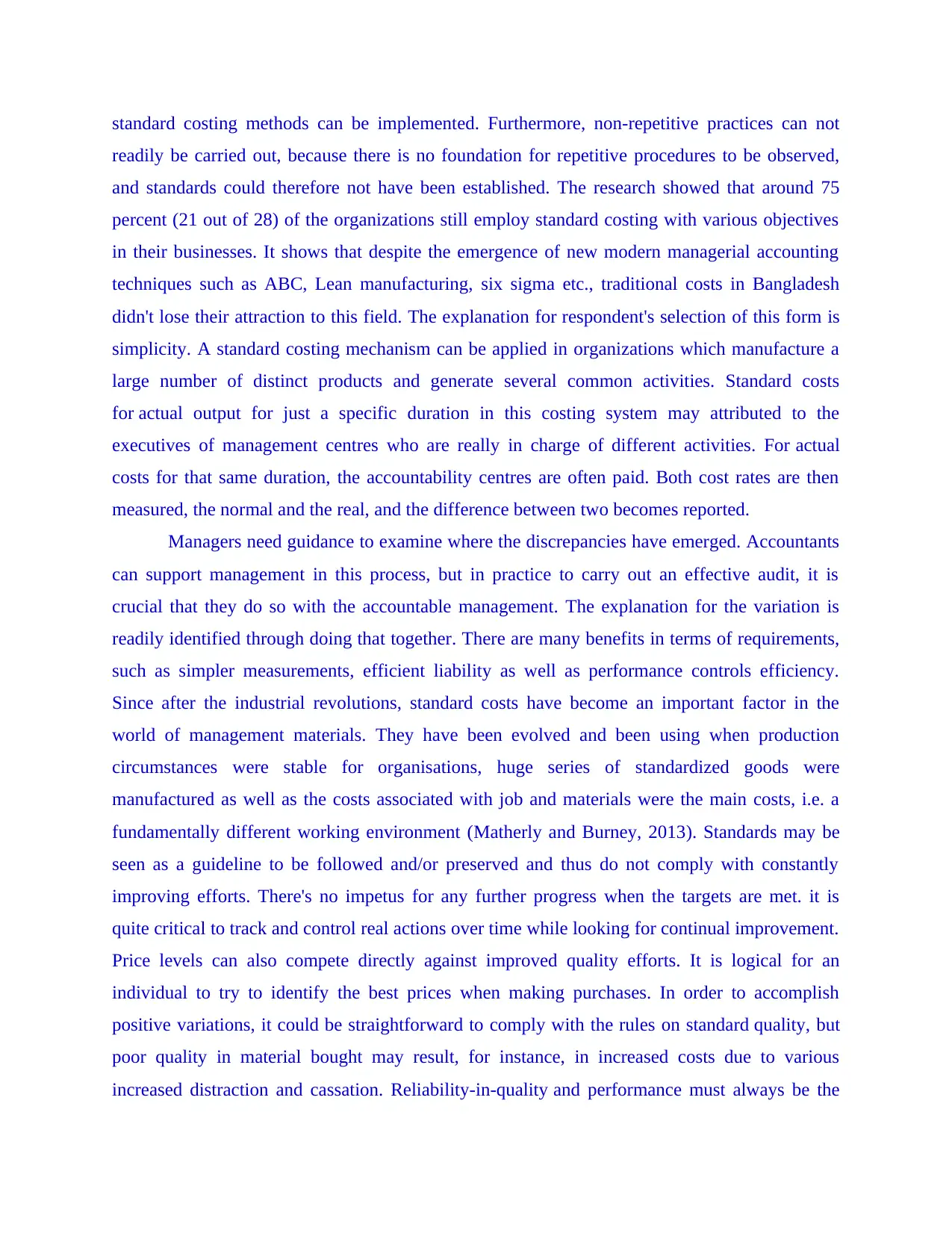
standard costing methods can be implemented. Furthermore, non-repetitive practices can not
readily be carried out, because there is no foundation for repetitive procedures to be observed,
and standards could therefore not have been established. The research showed that around 75
percent (21 out of 28) of the organizations still employ standard costing with various objectives
in their businesses. It shows that despite the emergence of new modern managerial accounting
techniques such as ABC, Lean manufacturing, six sigma etc., traditional costs in Bangladesh
didn't lose their attraction to this field. The explanation for respondent's selection of this form is
simplicity. A standard costing mechanism can be applied in organizations which manufacture a
large number of distinct products and generate several common activities. Standard costs
for actual output for just a specific duration in this costing system may attributed to the
executives of management centres who are really in charge of different activities. For actual
costs for that same duration, the accountability centres are often paid. Both cost rates are then
measured, the normal and the real, and the difference between two becomes reported.
Managers need guidance to examine where the discrepancies have emerged. Accountants
can support management in this process, but in practice to carry out an effective audit, it is
crucial that they do so with the accountable management. The explanation for the variation is
readily identified through doing that together. There are many benefits in terms of requirements,
such as simpler measurements, efficient liability as well as performance controls efficiency.
Since after the industrial revolutions, standard costs have become an important factor in the
world of management materials. They have been evolved and been using when production
circumstances were stable for organisations, huge series of standardized goods were
manufactured as well as the costs associated with job and materials were the main costs, i.e. a
fundamentally different working environment (Matherly and Burney, 2013). Standards may be
seen as a guideline to be followed and/or preserved and thus do not comply with constantly
improving efforts. There's no impetus for any further progress when the targets are met. it is
quite critical to track and control real actions over time while looking for continual improvement.
Price levels can also compete directly against improved quality efforts. It is logical for an
individual to try to identify the best prices when making purchases. In order to accomplish
positive variations, it could be straightforward to comply with the rules on standard quality, but
poor quality in material bought may result, for instance, in increased costs due to various
increased distraction and cassation. Reliability-in-quality and performance must always be the
readily be carried out, because there is no foundation for repetitive procedures to be observed,
and standards could therefore not have been established. The research showed that around 75
percent (21 out of 28) of the organizations still employ standard costing with various objectives
in their businesses. It shows that despite the emergence of new modern managerial accounting
techniques such as ABC, Lean manufacturing, six sigma etc., traditional costs in Bangladesh
didn't lose their attraction to this field. The explanation for respondent's selection of this form is
simplicity. A standard costing mechanism can be applied in organizations which manufacture a
large number of distinct products and generate several common activities. Standard costs
for actual output for just a specific duration in this costing system may attributed to the
executives of management centres who are really in charge of different activities. For actual
costs for that same duration, the accountability centres are often paid. Both cost rates are then
measured, the normal and the real, and the difference between two becomes reported.
Managers need guidance to examine where the discrepancies have emerged. Accountants
can support management in this process, but in practice to carry out an effective audit, it is
crucial that they do so with the accountable management. The explanation for the variation is
readily identified through doing that together. There are many benefits in terms of requirements,
such as simpler measurements, efficient liability as well as performance controls efficiency.
Since after the industrial revolutions, standard costs have become an important factor in the
world of management materials. They have been evolved and been using when production
circumstances were stable for organisations, huge series of standardized goods were
manufactured as well as the costs associated with job and materials were the main costs, i.e. a
fundamentally different working environment (Matherly and Burney, 2013). Standards may be
seen as a guideline to be followed and/or preserved and thus do not comply with constantly
improving efforts. There's no impetus for any further progress when the targets are met. it is
quite critical to track and control real actions over time while looking for continual improvement.
Price levels can also compete directly against improved quality efforts. It is logical for an
individual to try to identify the best prices when making purchases. In order to accomplish
positive variations, it could be straightforward to comply with the rules on standard quality, but
poor quality in material bought may result, for instance, in increased costs due to various
increased distraction and cassation. Reliability-in-quality and performance must always be the
⊘ This is a preview!⊘
Do you want full access?
Subscribe today to unlock all pages.

Trusted by 1+ million students worldwide
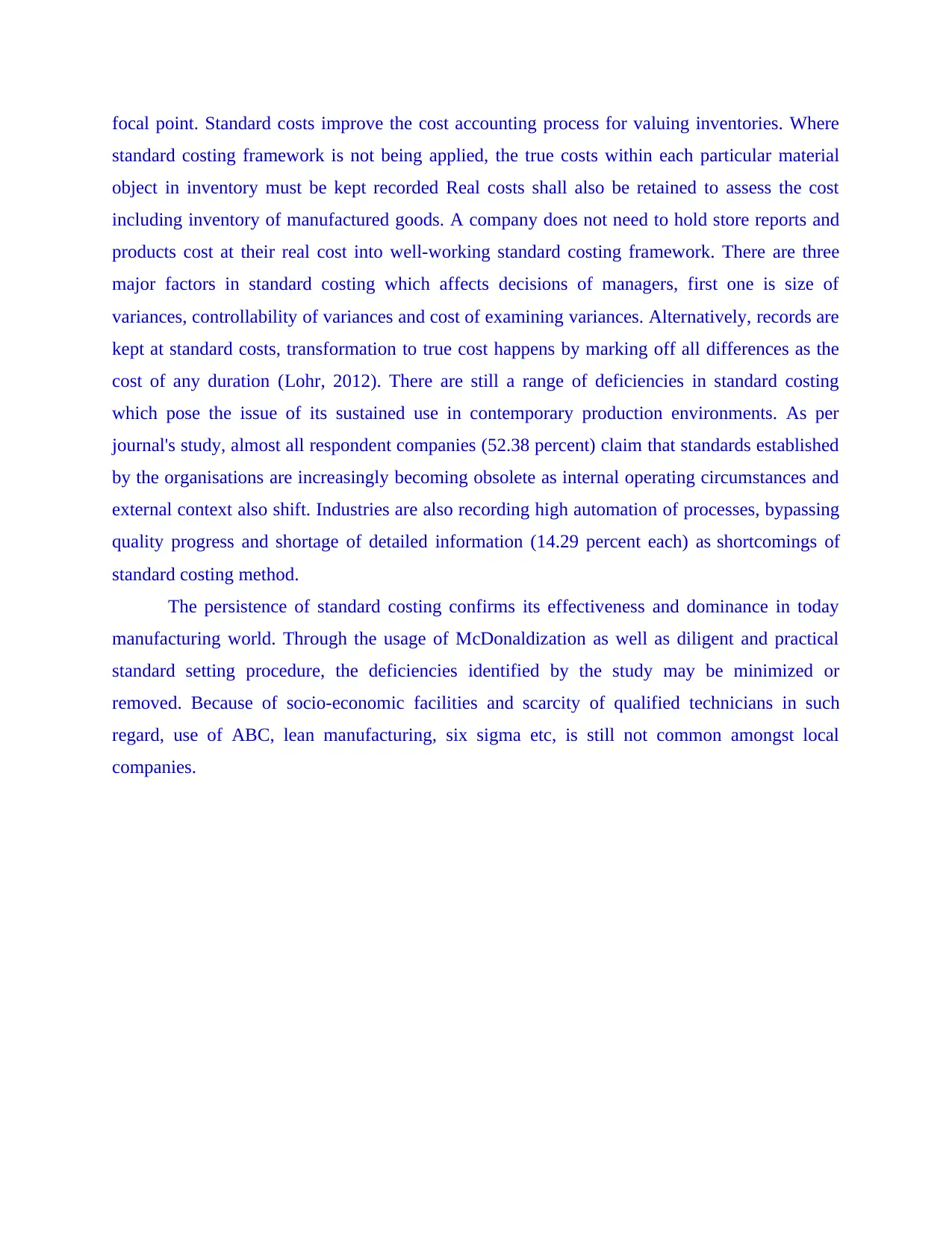
focal point. Standard costs improve the cost accounting process for valuing inventories. Where
standard costing framework is not being applied, the true costs within each particular material
object in inventory must be kept recorded Real costs shall also be retained to assess the cost
including inventory of manufactured goods. A company does not need to hold store reports and
products cost at their real cost into well-working standard costing framework. There are three
major factors in standard costing which affects decisions of managers, first one is size of
variances, controllability of variances and cost of examining variances. Alternatively, records are
kept at standard costs, transformation to true cost happens by marking off all differences as the
cost of any duration (Lohr, 2012). There are still a range of deficiencies in standard costing
which pose the issue of its sustained use in contemporary production environments. As per
journal's study, almost all respondent companies (52.38 percent) claim that standards established
by the organisations are increasingly becoming obsolete as internal operating circumstances and
external context also shift. Industries are also recording high automation of processes, bypassing
quality progress and shortage of detailed information (14.29 percent each) as shortcomings of
standard costing method.
The persistence of standard costing confirms its effectiveness and dominance in today
manufacturing world. Through the usage of McDonaldization as well as diligent and practical
standard setting procedure, the deficiencies identified by the study may be minimized or
removed. Because of socio-economic facilities and scarcity of qualified technicians in such
regard, use of ABC, lean manufacturing, six sigma etc, is still not common amongst local
companies.
standard costing framework is not being applied, the true costs within each particular material
object in inventory must be kept recorded Real costs shall also be retained to assess the cost
including inventory of manufactured goods. A company does not need to hold store reports and
products cost at their real cost into well-working standard costing framework. There are three
major factors in standard costing which affects decisions of managers, first one is size of
variances, controllability of variances and cost of examining variances. Alternatively, records are
kept at standard costs, transformation to true cost happens by marking off all differences as the
cost of any duration (Lohr, 2012). There are still a range of deficiencies in standard costing
which pose the issue of its sustained use in contemporary production environments. As per
journal's study, almost all respondent companies (52.38 percent) claim that standards established
by the organisations are increasingly becoming obsolete as internal operating circumstances and
external context also shift. Industries are also recording high automation of processes, bypassing
quality progress and shortage of detailed information (14.29 percent each) as shortcomings of
standard costing method.
The persistence of standard costing confirms its effectiveness and dominance in today
manufacturing world. Through the usage of McDonaldization as well as diligent and practical
standard setting procedure, the deficiencies identified by the study may be minimized or
removed. Because of socio-economic facilities and scarcity of qualified technicians in such
regard, use of ABC, lean manufacturing, six sigma etc, is still not common amongst local
companies.
Paraphrase This Document
Need a fresh take? Get an instant paraphrase of this document with our AI Paraphraser
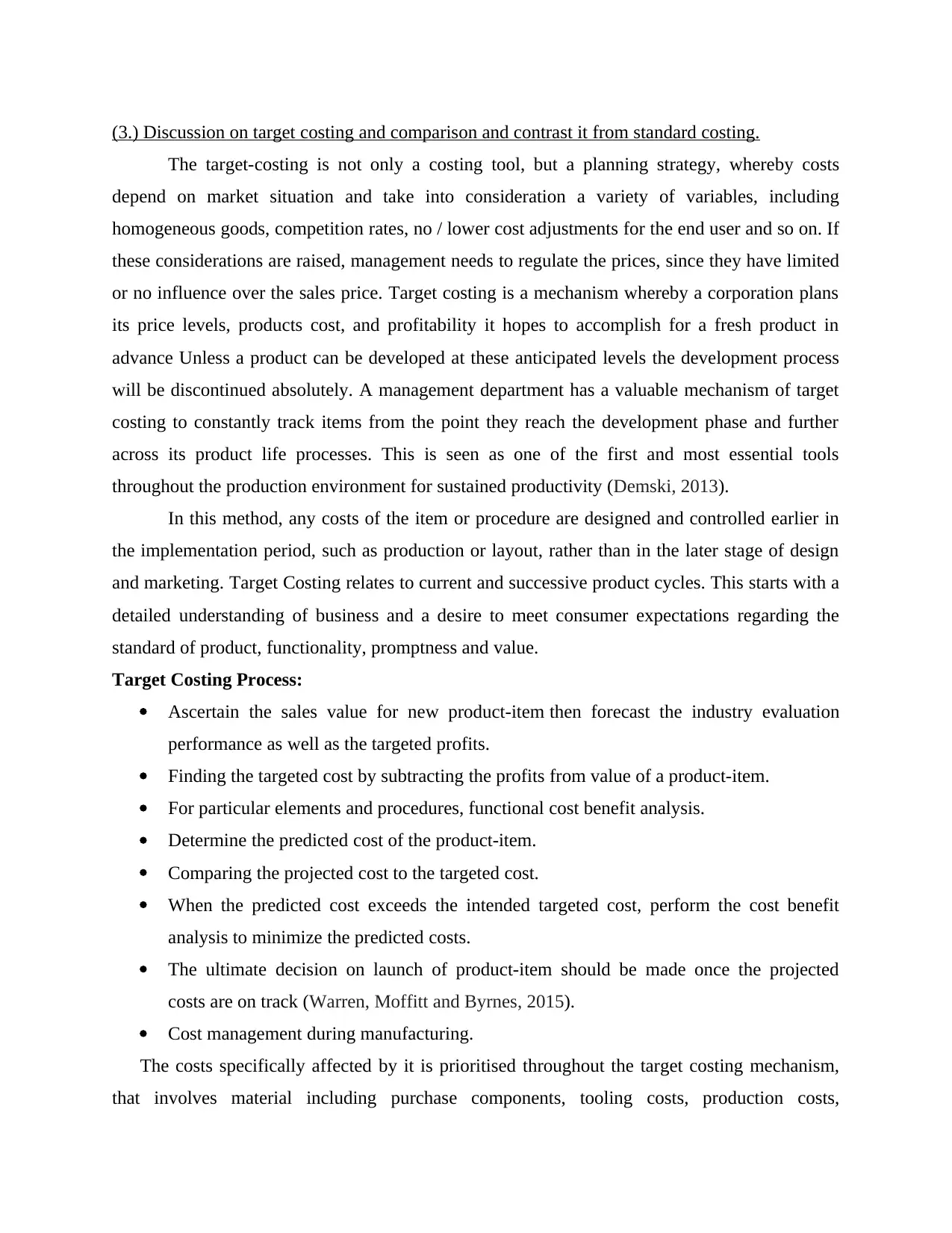
(3.) Discussion on target costing and comparison and contrast it from standard costing.
The target-costing is not only a costing tool, but a planning strategy, whereby costs
depend on market situation and take into consideration a variety of variables, including
homogeneous goods, competition rates, no / lower cost adjustments for the end user and so on. If
these considerations are raised, management needs to regulate the prices, since they have limited
or no influence over the sales price. Target costing is a mechanism whereby a corporation plans
its price levels, products cost, and profitability it hopes to accomplish for a fresh product in
advance Unless a product can be developed at these anticipated levels the development process
will be discontinued absolutely. A management department has a valuable mechanism of target
costing to constantly track items from the point they reach the development phase and further
across its product life processes. This is seen as one of the first and most essential tools
throughout the production environment for sustained productivity (Demski, 2013).
In this method, any costs of the item or procedure are designed and controlled earlier in
the implementation period, such as production or layout, rather than in the later stage of design
and marketing. Target Costing relates to current and successive product cycles. This starts with a
detailed understanding of business and a desire to meet consumer expectations regarding the
standard of product, functionality, promptness and value.
Target Costing Process:
Ascertain the sales value for new product-item then forecast the industry evaluation
performance as well as the targeted profits.
Finding the targeted cost by subtracting the profits from value of a product-item.
For particular elements and procedures, functional cost benefit analysis.
Determine the predicted cost of the product-item.
Comparing the projected cost to the targeted cost.
When the predicted cost exceeds the intended targeted cost, perform the cost benefit
analysis to minimize the predicted costs.
The ultimate decision on launch of product-item should be made once the projected
costs are on track (Warren, Moffitt and Byrnes, 2015).
Cost management during manufacturing.
The costs specifically affected by it is prioritised throughout the target costing mechanism,
that involves material including purchase components, tooling costs, production costs,
The target-costing is not only a costing tool, but a planning strategy, whereby costs
depend on market situation and take into consideration a variety of variables, including
homogeneous goods, competition rates, no / lower cost adjustments for the end user and so on. If
these considerations are raised, management needs to regulate the prices, since they have limited
or no influence over the sales price. Target costing is a mechanism whereby a corporation plans
its price levels, products cost, and profitability it hopes to accomplish for a fresh product in
advance Unless a product can be developed at these anticipated levels the development process
will be discontinued absolutely. A management department has a valuable mechanism of target
costing to constantly track items from the point they reach the development phase and further
across its product life processes. This is seen as one of the first and most essential tools
throughout the production environment for sustained productivity (Demski, 2013).
In this method, any costs of the item or procedure are designed and controlled earlier in
the implementation period, such as production or layout, rather than in the later stage of design
and marketing. Target Costing relates to current and successive product cycles. This starts with a
detailed understanding of business and a desire to meet consumer expectations regarding the
standard of product, functionality, promptness and value.
Target Costing Process:
Ascertain the sales value for new product-item then forecast the industry evaluation
performance as well as the targeted profits.
Finding the targeted cost by subtracting the profits from value of a product-item.
For particular elements and procedures, functional cost benefit analysis.
Determine the predicted cost of the product-item.
Comparing the projected cost to the targeted cost.
When the predicted cost exceeds the intended targeted cost, perform the cost benefit
analysis to minimize the predicted costs.
The ultimate decision on launch of product-item should be made once the projected
costs are on track (Warren, Moffitt and Byrnes, 2015).
Cost management during manufacturing.
The costs specifically affected by it is prioritised throughout the target costing mechanism,
that involves material including purchase components, tooling costs, production costs,
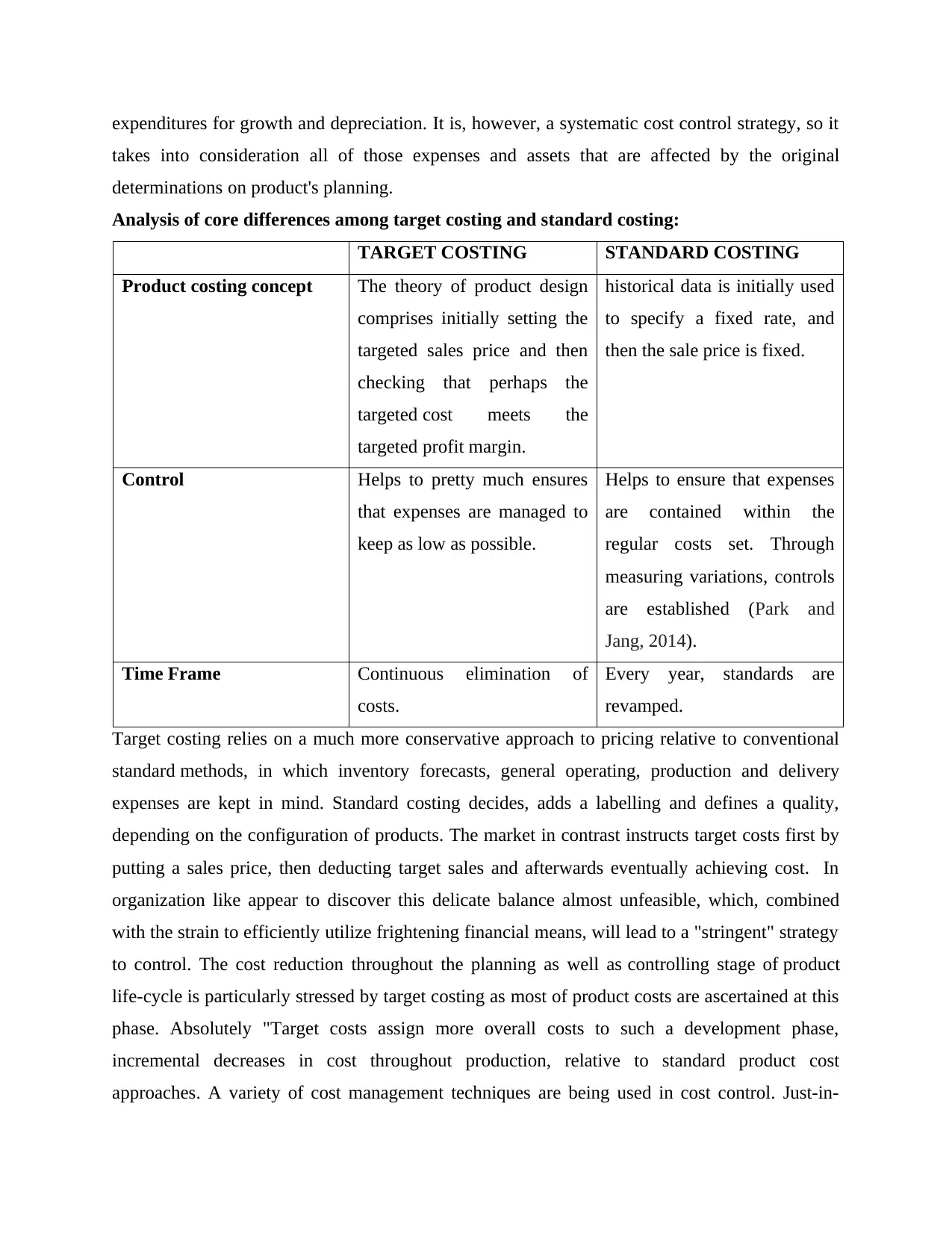
expenditures for growth and depreciation. It is, however, a systematic cost control strategy, so it
takes into consideration all of those expenses and assets that are affected by the original
determinations on product's planning.
Analysis of core differences among target costing and standard costing:
TARGET COSTING STANDARD COSTING
Product costing concept The theory of product design
comprises initially setting the
targeted sales price and then
checking that perhaps the
targeted cost meets the
targeted profit margin.
historical data is initially used
to specify a fixed rate, and
then the sale price is fixed.
Control Helps to pretty much ensures
that expenses are managed to
keep as low as possible.
Helps to ensure that expenses
are contained within the
regular costs set. Through
measuring variations, controls
are established (Park and
Jang, 2014).
Time Frame Continuous elimination of
costs.
Every year, standards are
revamped.
Target costing relies on a much more conservative approach to pricing relative to conventional
standard methods, in which inventory forecasts, general operating, production and delivery
expenses are kept in mind. Standard costing decides, adds a labelling and defines a quality,
depending on the configuration of products. The market in contrast instructs target costs first by
putting a sales price, then deducting target sales and afterwards eventually achieving cost. In
organization like appear to discover this delicate balance almost unfeasible, which, combined
with the strain to efficiently utilize frightening financial means, will lead to a "stringent" strategy
to control. The cost reduction throughout the planning as well as controlling stage of product
life-cycle is particularly stressed by target costing as most of product costs are ascertained at this
phase. Absolutely "Target costs assign more overall costs to such a development phase,
incremental decreases in cost throughout production, relative to standard product cost
approaches. A variety of cost management techniques are being used in cost control. Just-in-
takes into consideration all of those expenses and assets that are affected by the original
determinations on product's planning.
Analysis of core differences among target costing and standard costing:
TARGET COSTING STANDARD COSTING
Product costing concept The theory of product design
comprises initially setting the
targeted sales price and then
checking that perhaps the
targeted cost meets the
targeted profit margin.
historical data is initially used
to specify a fixed rate, and
then the sale price is fixed.
Control Helps to pretty much ensures
that expenses are managed to
keep as low as possible.
Helps to ensure that expenses
are contained within the
regular costs set. Through
measuring variations, controls
are established (Park and
Jang, 2014).
Time Frame Continuous elimination of
costs.
Every year, standards are
revamped.
Target costing relies on a much more conservative approach to pricing relative to conventional
standard methods, in which inventory forecasts, general operating, production and delivery
expenses are kept in mind. Standard costing decides, adds a labelling and defines a quality,
depending on the configuration of products. The market in contrast instructs target costs first by
putting a sales price, then deducting target sales and afterwards eventually achieving cost. In
organization like appear to discover this delicate balance almost unfeasible, which, combined
with the strain to efficiently utilize frightening financial means, will lead to a "stringent" strategy
to control. The cost reduction throughout the planning as well as controlling stage of product
life-cycle is particularly stressed by target costing as most of product costs are ascertained at this
phase. Absolutely "Target costs assign more overall costs to such a development phase,
incremental decreases in cost throughout production, relative to standard product cost
approaches. A variety of cost management techniques are being used in cost control. Just-in-
⊘ This is a preview!⊘
Do you want full access?
Subscribe today to unlock all pages.

Trusted by 1+ million students worldwide
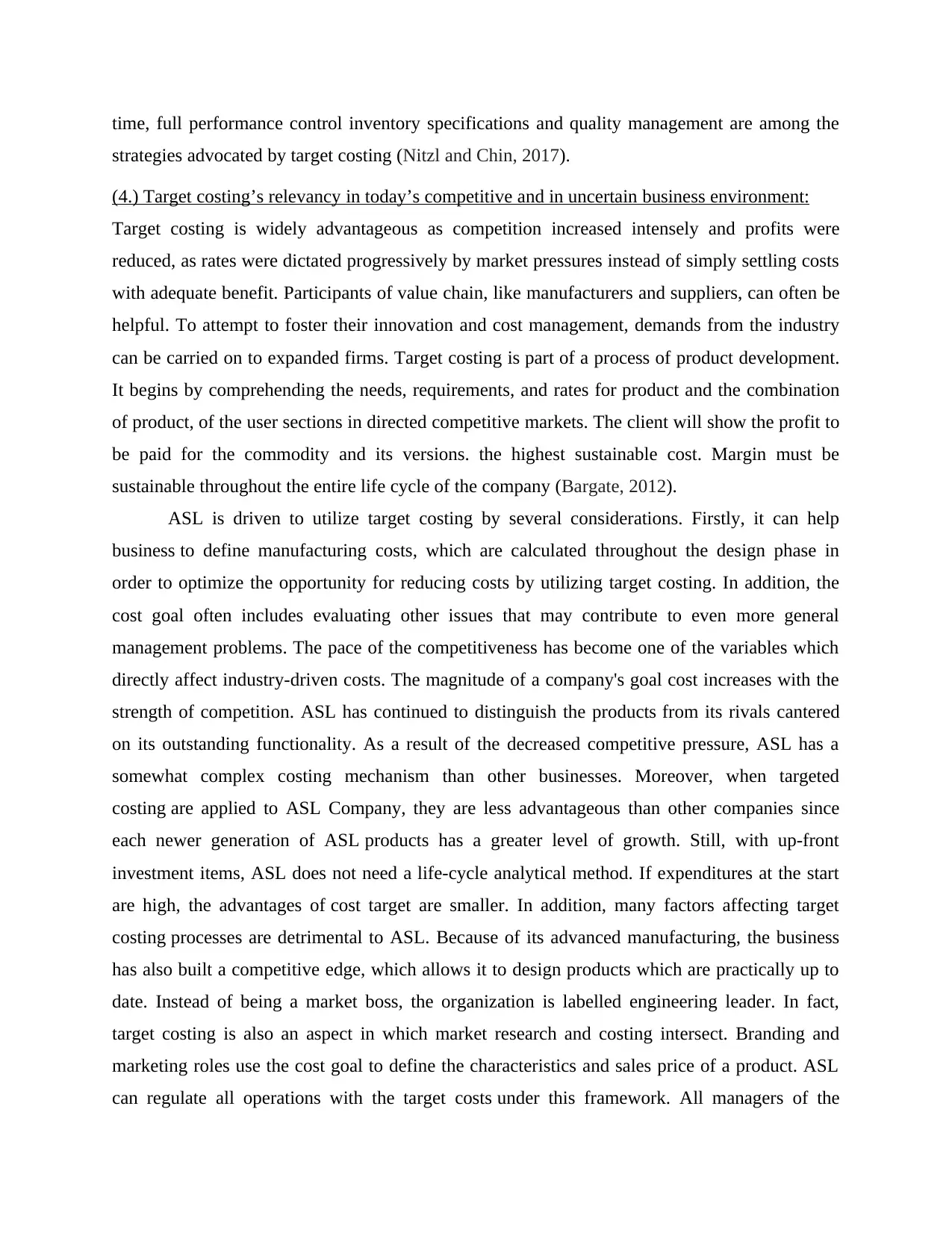
time, full performance control inventory specifications and quality management are among the
strategies advocated by target costing (Nitzl and Chin, 2017).
(4.) Target costing’s relevancy in today’s competitive and in uncertain business environment:
Target costing is widely advantageous as competition increased intensely and profits were
reduced, as rates were dictated progressively by market pressures instead of simply settling costs
with adequate benefit. Participants of value chain, like manufacturers and suppliers, can often be
helpful. To attempt to foster their innovation and cost management, demands from the industry
can be carried on to expanded firms. Target costing is part of a process of product development.
It begins by comprehending the needs, requirements, and rates for product and the combination
of product, of the user sections in directed competitive markets. The client will show the profit to
be paid for the commodity and its versions. the highest sustainable cost. Margin must be
sustainable throughout the entire life cycle of the company (Bargate, 2012).
ASL is driven to utilize target costing by several considerations. Firstly, it can help
business to define manufacturing costs, which are calculated throughout the design phase in
order to optimize the opportunity for reducing costs by utilizing target costing. In addition, the
cost goal often includes evaluating other issues that may contribute to even more general
management problems. The pace of the competitiveness has become one of the variables which
directly affect industry-driven costs. The magnitude of a company's goal cost increases with the
strength of competition. ASL has continued to distinguish the products from its rivals cantered
on its outstanding functionality. As a result of the decreased competitive pressure, ASL has a
somewhat complex costing mechanism than other businesses. Moreover, when targeted
costing are applied to ASL Company, they are less advantageous than other companies since
each newer generation of ASL products has a greater level of growth. Still, with up-front
investment items, ASL does not need a life-cycle analytical method. If expenditures at the start
are high, the advantages of cost target are smaller. In addition, many factors affecting target
costing processes are detrimental to ASL. Because of its advanced manufacturing, the business
has also built a competitive edge, which allows it to design products which are practically up to
date. Instead of being a market boss, the organization is labelled engineering leader. In fact,
target costing is also an aspect in which market research and costing intersect. Branding and
marketing roles use the cost goal to define the characteristics and sales price of a product. ASL
can regulate all operations with the target costs under this framework. All managers of the
strategies advocated by target costing (Nitzl and Chin, 2017).
(4.) Target costing’s relevancy in today’s competitive and in uncertain business environment:
Target costing is widely advantageous as competition increased intensely and profits were
reduced, as rates were dictated progressively by market pressures instead of simply settling costs
with adequate benefit. Participants of value chain, like manufacturers and suppliers, can often be
helpful. To attempt to foster their innovation and cost management, demands from the industry
can be carried on to expanded firms. Target costing is part of a process of product development.
It begins by comprehending the needs, requirements, and rates for product and the combination
of product, of the user sections in directed competitive markets. The client will show the profit to
be paid for the commodity and its versions. the highest sustainable cost. Margin must be
sustainable throughout the entire life cycle of the company (Bargate, 2012).
ASL is driven to utilize target costing by several considerations. Firstly, it can help
business to define manufacturing costs, which are calculated throughout the design phase in
order to optimize the opportunity for reducing costs by utilizing target costing. In addition, the
cost goal often includes evaluating other issues that may contribute to even more general
management problems. The pace of the competitiveness has become one of the variables which
directly affect industry-driven costs. The magnitude of a company's goal cost increases with the
strength of competition. ASL has continued to distinguish the products from its rivals cantered
on its outstanding functionality. As a result of the decreased competitive pressure, ASL has a
somewhat complex costing mechanism than other businesses. Moreover, when targeted
costing are applied to ASL Company, they are less advantageous than other companies since
each newer generation of ASL products has a greater level of growth. Still, with up-front
investment items, ASL does not need a life-cycle analytical method. If expenditures at the start
are high, the advantages of cost target are smaller. In addition, many factors affecting target
costing processes are detrimental to ASL. Because of its advanced manufacturing, the business
has also built a competitive edge, which allows it to design products which are practically up to
date. Instead of being a market boss, the organization is labelled engineering leader. In fact,
target costing is also an aspect in which market research and costing intersect. Branding and
marketing roles use the cost goal to define the characteristics and sales price of a product. ASL
can regulate all operations with the target costs under this framework. All managers of the
Paraphrase This Document
Need a fresh take? Get an instant paraphrase of this document with our AI Paraphraser
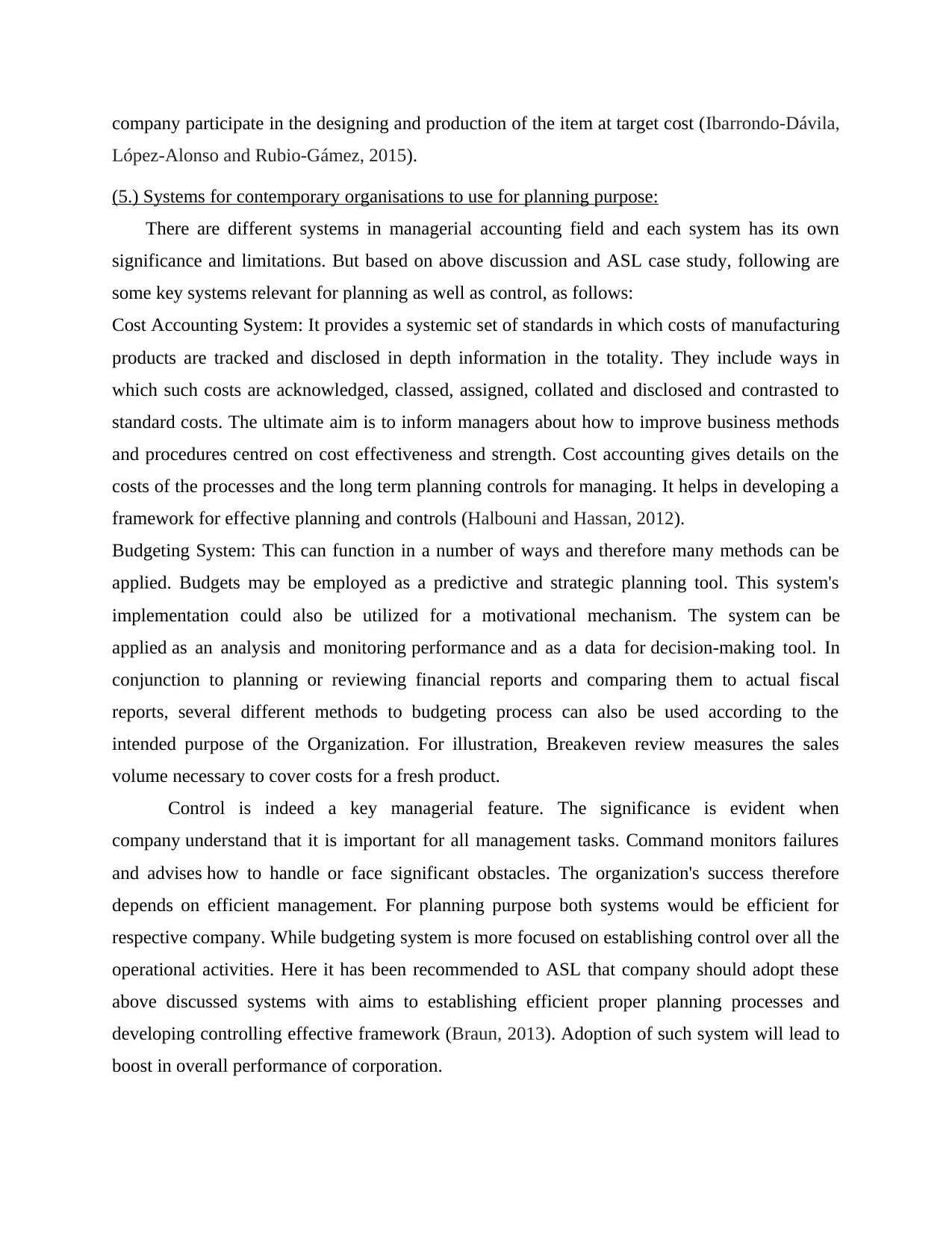
company participate in the designing and production of the item at target cost (Ibarrondo-Dávila,
López-Alonso and Rubio-Gámez, 2015).
(5.) Systems for contemporary organisations to use for planning purpose:
There are different systems in managerial accounting field and each system has its own
significance and limitations. But based on above discussion and ASL case study, following are
some key systems relevant for planning as well as control, as follows:
Cost Accounting System: It provides a systemic set of standards in which costs of manufacturing
products are tracked and disclosed in depth information in the totality. They include ways in
which such costs are acknowledged, classed, assigned, collated and disclosed and contrasted to
standard costs. The ultimate aim is to inform managers about how to improve business methods
and procedures centred on cost effectiveness and strength. Cost accounting gives details on the
costs of the processes and the long term planning controls for managing. It helps in developing a
framework for effective planning and controls (Halbouni and Hassan, 2012).
Budgeting System: This can function in a number of ways and therefore many methods can be
applied. Budgets may be employed as a predictive and strategic planning tool. This system's
implementation could also be utilized for a motivational mechanism. The system can be
applied as an analysis and monitoring performance and as a data for decision-making tool. In
conjunction to planning or reviewing financial reports and comparing them to actual fiscal
reports, several different methods to budgeting process can also be used according to the
intended purpose of the Organization. For illustration, Breakeven review measures the sales
volume necessary to cover costs for a fresh product.
Control is indeed a key managerial feature. The significance is evident when
company understand that it is important for all management tasks. Command monitors failures
and advises how to handle or face significant obstacles. The organization's success therefore
depends on efficient management. For planning purpose both systems would be efficient for
respective company. While budgeting system is more focused on establishing control over all the
operational activities. Here it has been recommended to ASL that company should adopt these
above discussed systems with aims to establishing efficient proper planning processes and
developing controlling effective framework (Braun, 2013). Adoption of such system will lead to
boost in overall performance of corporation.
López-Alonso and Rubio-Gámez, 2015).
(5.) Systems for contemporary organisations to use for planning purpose:
There are different systems in managerial accounting field and each system has its own
significance and limitations. But based on above discussion and ASL case study, following are
some key systems relevant for planning as well as control, as follows:
Cost Accounting System: It provides a systemic set of standards in which costs of manufacturing
products are tracked and disclosed in depth information in the totality. They include ways in
which such costs are acknowledged, classed, assigned, collated and disclosed and contrasted to
standard costs. The ultimate aim is to inform managers about how to improve business methods
and procedures centred on cost effectiveness and strength. Cost accounting gives details on the
costs of the processes and the long term planning controls for managing. It helps in developing a
framework for effective planning and controls (Halbouni and Hassan, 2012).
Budgeting System: This can function in a number of ways and therefore many methods can be
applied. Budgets may be employed as a predictive and strategic planning tool. This system's
implementation could also be utilized for a motivational mechanism. The system can be
applied as an analysis and monitoring performance and as a data for decision-making tool. In
conjunction to planning or reviewing financial reports and comparing them to actual fiscal
reports, several different methods to budgeting process can also be used according to the
intended purpose of the Organization. For illustration, Breakeven review measures the sales
volume necessary to cover costs for a fresh product.
Control is indeed a key managerial feature. The significance is evident when
company understand that it is important for all management tasks. Command monitors failures
and advises how to handle or face significant obstacles. The organization's success therefore
depends on efficient management. For planning purpose both systems would be efficient for
respective company. While budgeting system is more focused on establishing control over all the
operational activities. Here it has been recommended to ASL that company should adopt these
above discussed systems with aims to establishing efficient proper planning processes and
developing controlling effective framework (Braun, 2013). Adoption of such system will lead to
boost in overall performance of corporation.
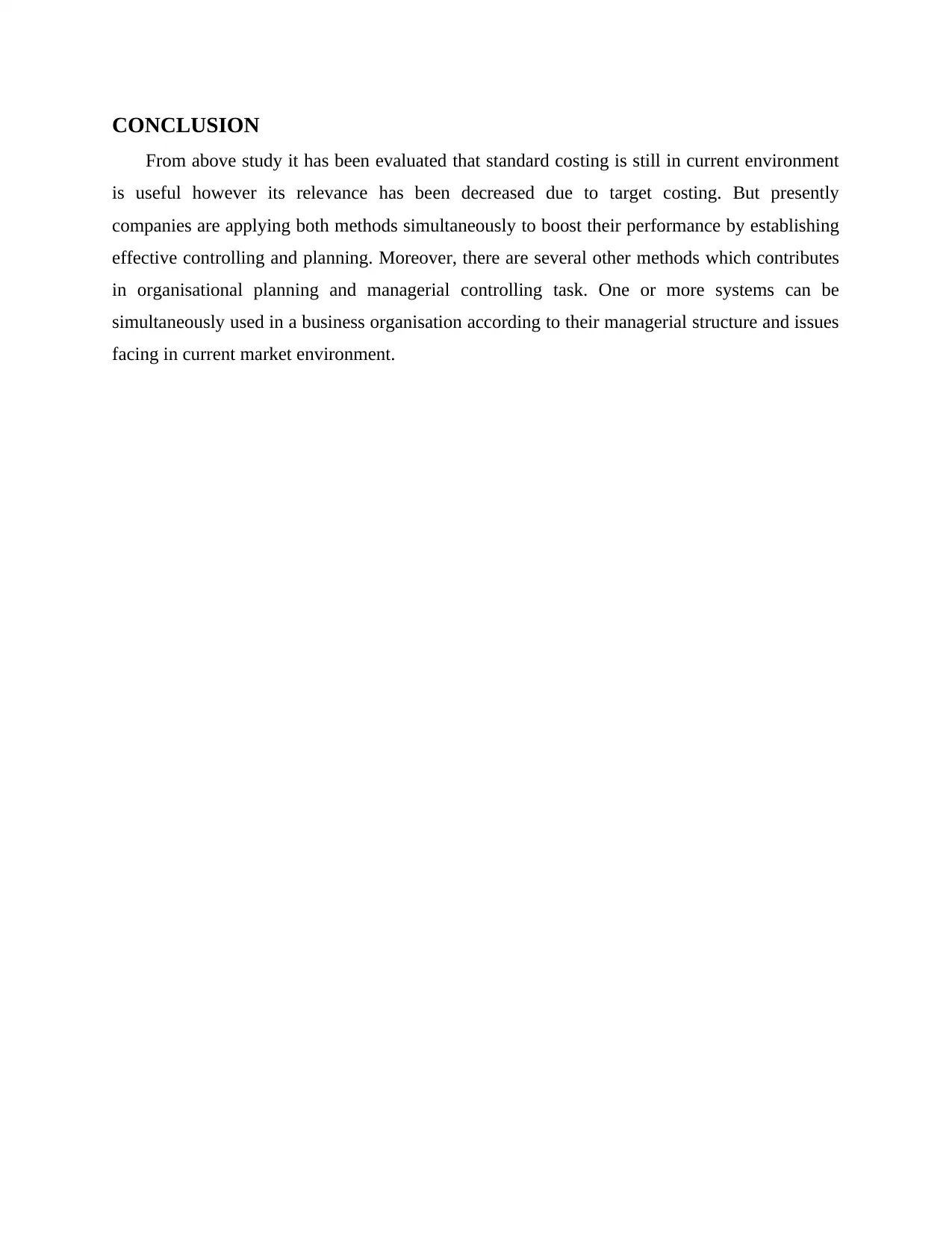
CONCLUSION
From above study it has been evaluated that standard costing is still in current environment
is useful however its relevance has been decreased due to target costing. But presently
companies are applying both methods simultaneously to boost their performance by establishing
effective controlling and planning. Moreover, there are several other methods which contributes
in organisational planning and managerial controlling task. One or more systems can be
simultaneously used in a business organisation according to their managerial structure and issues
facing in current market environment.
From above study it has been evaluated that standard costing is still in current environment
is useful however its relevance has been decreased due to target costing. But presently
companies are applying both methods simultaneously to boost their performance by establishing
effective controlling and planning. Moreover, there are several other methods which contributes
in organisational planning and managerial controlling task. One or more systems can be
simultaneously used in a business organisation according to their managerial structure and issues
facing in current market environment.
⊘ This is a preview!⊘
Do you want full access?
Subscribe today to unlock all pages.

Trusted by 1+ million students worldwide
1 out of 13
Related Documents
Your All-in-One AI-Powered Toolkit for Academic Success.
+13062052269
info@desklib.com
Available 24*7 on WhatsApp / Email
![[object Object]](/_next/static/media/star-bottom.7253800d.svg)
Unlock your academic potential
Copyright © 2020–2025 A2Z Services. All Rights Reserved. Developed and managed by ZUCOL.





